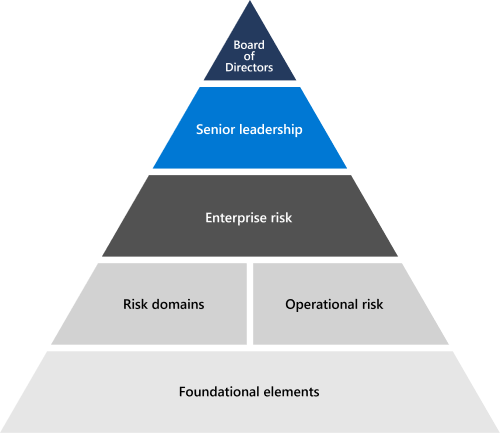
Microsoft understands that effective security policies must be implemented consistently across the enterprise to protect Microsoft information systems and customers. Security policies must also account for variations in business functions and information systems to be universally applicable. To meet these requirements, Microsoft implements a comprehensive security governance program as a part of the Microsoft Policy Framework. Security governance falls under the Microsoft Security Policy (MSP).
The MSP organizes Microsoft's security policies, standards, and requirements so they can be implemented across all Microsoft engineering groups and business units. Individual business units are responsible for specific implementations of Microsoft security policies. For example, Microsoft 365 documents its security implementations in the Microsoft 365 Information Security Policy and the related Microsoft 365 Control Framework. Azure and Dynamics 365 document their security implementations in the Standard Operating Procedures (SOPs) and the Azure Control Framework. These security implementations align with the goals and objectives of the MSP.
Microsoft's security governance program is informed by and aligns with various regulatory and compliance frameworks. Security requirements are constantly evolving to account for new technologies, regulatory and compliance requirements, and security threats. Because of these changes, Microsoft regularly updates our security policies and supporting documents to protect Microsoft systems and customers, meet our commitments, and maintain customer trust.
Microsoft 365 documents security implementations in the Microsoft 365 Information Security Policy. This policy aligns with the Microsoft Security Policy and governs the Microsoft 365 information system, including all Microsoft 365 environments and all resources involved in the collection, processing, maintenance, use, sharing, dissemination, and disposal of data. Similarly, Azure and Dynamics 365 use the Microsoft Security Policy to govern their information system.
The information systems include the following components governed by the Microsoft 365 Information Security Policy (for Microsoft 365) and the Microsoft Security Policy (for Azure and Dynamics 365):
The Microsoft 365 Information Security Policy is supplemented by the Microsoft 365 Control Framework. The Microsoft 365 Control Framework details the minimum-security requirements for all Microsoft 365 services and information system components. It also references the legal and corporate requirements behind each control. The framework includes control activity names, descriptions, and guidance to ensure effective control implementations by service teams. Microsoft 365 uses the control framework to track control implementations for internal and external reporting. Similarly, Azure and Dynamics 365 record control implementations in the Azure Control Framework.
All exceptions to the Control Frameworks must have legitimate business justification and be approved by an appropriate governance entity within each online services team. Depending on the scope of the exception and the potential risk it represents, approval for exceptions may need to be obtained from a corporate vice president or higher. Exceptions are managed in a tracking tool where they are reviewed and approved for continued relevance.
Risk management is the process of identifying, assessing, and responding to threats or events that can impact Company or customer objectives. Risk management at Microsoft is designed to anticipate new threats and provide ongoing security for our cloud systems and the customers who use them.
Microsoft's risk management align to the Enterprise Risk Management (ERM) framework. ERM enables the overall enterprise risk management process and works with management across the enterprise to identify and ensure accountability for Microsoft's most significant risks.

Microsoft ERM enables common risk management principles across the enterprise so business units can independently facilitate consistent and comparative risk assessments. This coordination gives Microsoft the ability to aggregate and report risk information in a consolidated manner for management. ERM provides business units in Microsoft with common methodologies, tools, and goals for the risk management process. Microsoft 365 and other engineering groups and business units use these tools to conduct individual risk assessments as part of their own risk management programs under the guidance of ERM.
Each online service follows ERM guidance to manage risks across Microsoft services. The program focuses on aligning the ERM framework with existing Microsoft engineering, service operations, and compliance processes, making the Risk Management program more effective and efficient. Each online service's risk management activities ultimately roll up into and inform the ERM process.
As part of risk assessment activities, each online service analyzes design and operating effectiveness of controls implemented as part of the Microsoft Controls Framework (Framework). The Framework is a rationalized set of controls that, when properly implemented along with supporting compliance activities, allows engineering teams to comply with key regulations and certifications.
Governance, Risk, and Compliance teams of each online service (GRC) work to maintain the Control Framework on an ongoing basis. Several scenarios may require the GRC team to update the control framework, including changes in relevant regulations or laws, emerging threats, penetration test results, security incidents, audit feedback, and new compliance requirements. When a framework change is required, the Trust team identifies key stakeholders responsible for approving and implementing the change to ensure it is feasible and will not cause unintended issues with Online services. Once the GRC team and relevant stakeholders agree on what the change requires, the workloads responsible for implementing the change set target completion dates and work to implement the change within their respective services. After implementation targets have been met, the Trust team updates the control framework with the new or updated controls.
Microsoft's online services are regularly audited for compliance with external regulations and certifications. Refer to the following table for validation of controls related to governance, risk, and compliance.
| External audits | Section | Latest report date |
|---|---|---|
| FedRAMP (Office 365) | CA-2: Security assessments CA-5: Plan of action and milestones PL-2: System security plan RA-3: Risk assessment | July 31, 2023 |
| ISO 27001/27017 |